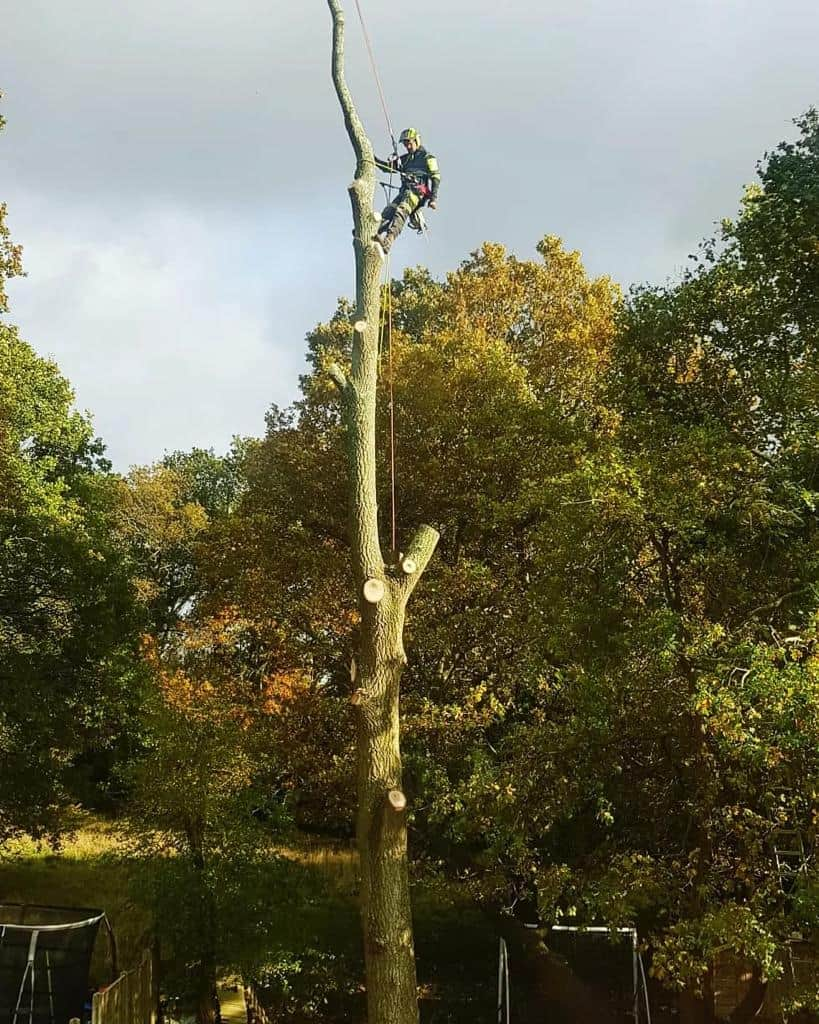When a tree is removed from a property, one of the most common follow-up services is stump grinding. While this process is highly effective for eliminating the remaining stump and roots, many homeowners have concerns about its potential impact on surrounding plants, flowers, and landscaping.
If you’re considering stump grinding but are unsure of its effects on your garden, you’re in the right place. In this blog post, we’ll answer the question of whether stump grinding can damage surrounding plants and provide you with the information you need to make an informed decision.
What is Stump Grinding?
Stump grinding is the process of using a powerful machine to grind down the remaining part of the tree stump after a tree has been felled. The machine works by using a rotating blade to chip away at the stump and roots, turning it into wood chips and sawdust. This process effectively removes the stump, allowing for the space to be repurposed, whether it’s for new planting, a lawn, or another landscaping project.
Can Stump Grinding Affect Surrounding Plants?
The short answer is that stump grinding can potentially affect nearby plants, but with the proper care and technique, the impact can be minimised. Let’s break it down:
1. Root Disturbance
One of the main concerns about stump grinding is the potential disruption of nearby plant roots. Tree roots often spread out in all directions, and if your plants or shrubs are planted close to the stump, there is a risk that their root systems could be affected during the grinding process. This is particularly true for smaller plants with shallow roots that may be located near the stump.
While stump grinding machines focus on the tree stump and the surrounding root system, it is possible that some of the machine’s vibrations could extend to neighbouring plants and disturb their roots. The severity of this depends on the proximity of the plants to the stump and the depth of their root systems.
2. Soil Displacement
During the stump grinding process, soil around the stump may be disturbed. The wood chips and sawdust created by grinding are often removed, but if any soil is displaced, it could affect the surrounding area. This may cause some plants to lose essential nutrients or disrupt their root systems, particularly if the soil is removed in significant amounts.
3. Increased Sun Exposure
After stump grinding, the area may be left with a large exposed patch of ground, particularly if there was previously thick vegetation around the tree. This may increase the amount of sunlight that reaches the surrounding plants, which could stress plants that thrive in shaded conditions. Additionally, some plants may struggle to adapt to the sudden change in their environment if the surrounding area becomes too dry due to increased exposure.
4. Impact of Wood Chips and Sawdust
Wood chips and sawdust are by-products of stump grinding. These materials can be left on the ground after the process, and while they can be useful for mulching or composting, they can sometimes suffocate plants if left in large piles. Excessive amounts of mulch or sawdust can restrict airflow to the soil, potentially preventing plants from receiving sufficient oxygen and water. It’s important to ensure that wood chips are either removed or spread thinly over the area to prevent this from happening.
How to Minimise the Impact of Stump Grinding on Surrounding Plants
While stump grinding does have the potential to affect surrounding plants, there are several ways to minimise these impacts and ensure your plants are not harmed. Here’s how:
1. Pre-Planning and Plant Protection
Before scheduling a stump grinding service, carefully assess the area and consider the location of surrounding plants. A professional tree surgeon can advise you on how to best protect your plants and prepare the area. For plants that are at high risk, you may wish to temporarily remove them or cover them with a protective tarp during the grinding process.
2. Controlled Grinding Depth
Professional tree surgeons can control the depth of the stump grinding process. By focusing on grinding just below the surface level of the stump, they can minimise disruption to the surrounding roots and plants. This method is ideal for situations where nearby plants have shallow root systems that are vulnerable to disturbance.
3. Proper Disposal of Wood Chips and Sawdust
Once the stump grinding is complete, the wood chips and sawdust should be appropriately removed or redistributed. If you choose to keep the wood chips, use them sparingly as mulch and ensure they are evenly spread over the area to avoid suffocating your plants. If you decide to remove them, ensure that the ground is cleared and left in a stable condition for replanting.
4. Replanting and Regrowth
After stump grinding, you may need to replant or restore the area. With a little care, you can revitalise the area and promote healthy plant growth. If any plants were stressed by the grinding, consider replanting them in a different location, or make adjustments to improve the soil conditions and nutrient levels.
Conclusion
Stump grinding is an efficient way to remove a tree stump and its roots, but it’s essential to consider its potential effects on surrounding plants. While there are some risks involved, these can be minimised with careful planning and professional execution. A skilled tree surgeon will take the necessary steps to protect your plants and ensure that the area is left in optimal condition for future growth.
If you’re considering stump grinding for your property and have concerns about the impact on surrounding plants, don’t hesitate to reach out to us at LM Tree Surgery Whiteley. Our expert team will ensure that your stump removal is done with the utmost care, preserving the health of your garden while delivering exceptional results.
Call us on: 01489 359 894
Click here to find out more about LM Tree Surgery Whiteley
Click here to complete our contact form and see how we can help with your tree needs.

